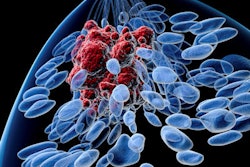Sunday, November 29 | 11:55 a.m.-12:05 p.m. | SSA20-08 | Room S404AB
High-resolution breast CT improves the assessment of 3D microcalcification clusters, addressing one of mammography's limitations: the superimposition of tissue, according to researchers from Germany.The technology has demonstrated efficacy in imaging soft tissue, but it has been hobbled by limited spatial resolution, according to a team led by Willi Kalender, PhD, of the University of Erlangen-Nuremberg. So Kalender's group designed a prototype breast CT scanner that has spatial resolution better than 100 µm, and compared the technology with full-field digital mammography for assessing microcalcification clusters in a breast phantom and breast specimens.
The researchers were able to keep breast CT radiation exposure below a 6-mGy average glandular dose. For the phantom, the technology visualized the "microcalcifications" (actually beads implanted in the phantom) down to 130 µm, while mammography visualized the beads down to 160 µm. In the breast specimens, CT visualized microcalcifications down to 100 µm, according to Kalender's group.
The bottom line? Breast CT is better than mammography at visualizing microcalcification clusters, and it avoids the effect of superimposition of tissue, which can lead to false positives, the team concluded.





















